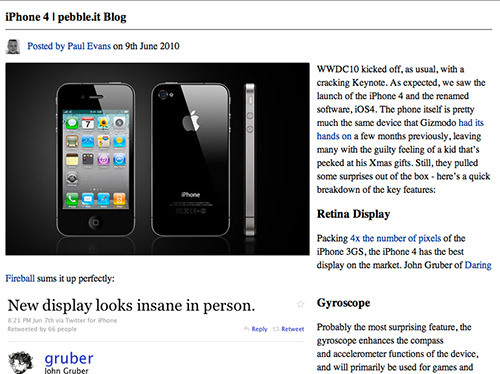You are the designer
New websites and tools for browsers are showing that users have more control over design than ever.
With the release of Safari 5 Apple added a Reader feature that takes a web page and formats it for easy reading. This type of feature has been around for a while in Chrome and Firefox via the Readability Extension (Chrome & Firefox) and gives users the option to reformat the page in a more readable format. Here’s the pebble blog reformated using Readability.

At pebble we’ve really been enjoying using these tools to get rid of unnecessary navigation and adverts, and correct poor typography.
What do websites need to be able to take advantage of this? Not much - providing you have used well-formed HTML your web pages will be neatly formatted by these extensions.
APIs also free content from design ¶
Another project that caught our eye this week was the reformatted Guardian site created by Phil Gyford. This takes content from the Guardian API and reformats it for easy reading. We have found it works particularly well on the iPad and is a great example of how publishing your content via an API can give it new contexts without any effort from the creators of the content.
Where does this leave the designer? ¶
We are the first to admit the importance of UI design but these examples show that, like it or not, you the user will have greater control over how content looks. Browsers are offering users more options to assign custom styles, turn parts of the page on and off or to change the layout entirely.
In our opinion this is a good thing. The web should be open and users should be able to choose how content appears.
And.. don’t change our reader ¶
Shortly after the Safari 5 feature several users began publishing custom styles for the Reader page allowing Safari users to change the way the reader page looked and Apple had intended.
This provoked unhappiness from Apple employees including Faruk Ateş who wrote:
Don’t risk unwitting users’ safety or their user experience with your hacking suggestions.
I’ll leave you to mull on the irony of that.
Using the browser to customise web pages will become more popular so expect designers to throw their toys out of their prams and users to rejoice that they can view pages how they want to.
Tags
Can you help make this article better? You can edit it here and send me a pull request.